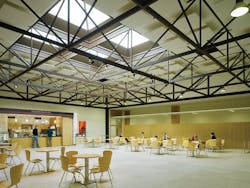The Dundalk Institute of Technology (DkIT) in Dundalk, County Louth, Ireland, is home to one of the finest examples of Miesien architecture in Europe, the PJ Carroll Building, listed as a property of national and international significance. It also is home to the first large commercial “urban turbine” in Ireland and the first large commercial wind turbine on a college campus in the world.
Though bountiful in Ireland, wind is inconsistent in nature. Often, the energy produced by the turbine exceeded demand and was wasted. At other times, the energy produced by the turbine was insufficient to meet demand.
Solution
BDP, an international firm consisting of architects, designers, engineers, and urbanists, recommended the use of IceBank energy-storage technology from CALMAC Manufacturing Corp. to smooth the load curve. The thermal-energy-storage tanks provide a way for DkIT to capture excess energy that previously would have been sold to the grid. With the energy-storage tanks and chiller installed underground, in a room adjacent to the building, the architectural integrity of the building remains intact.
Energy created by the turbine at night is stored in the tanks in the form of ice. Full charge of the energy storage, while not necessary for cooling the building, takes four hours. If wind energy is insufficient to meet electrical demand, the building-management system enables control routines that adjust heating and cooling temperature setpoints. This allows DkIT to consume less energy and avoid a utility fine.
“The installation went without any problems,” Christian Maas, building-services technical officer for DkIT, said. “The start-up and testing was also quite smooth.”
Edel Donnelly, building-services engineer for BDP, said, “This installation provides the perfect example of how buildings can be used to even the peaks and troughs created on the national grid by the addition of wind resources.”
Results
The wind turbine meets 30 percent of campus electrical-energy requirements, including 16 percent of the PJ Carroll Building’s load. With energy storage and wind energy, DkIT was able to lessen its dependence on traditional energy sources.
In addition to lessening environmental impact, thermal-energy storage lowered energy costs. From Aug. 26, 2011, to May 14, 2012, DkIT saved nearly $8,000 over a non-energy-storage system.1 Throughout 2012, the wind turbine was able to produce 1,440 MWh of electricity, of which 1,141 MWh were consumed by the university and 299 MWh were exported.
Energy-modeling calculations based on monthly figures show the wind turbine in combination with the energy-storage tanks could provide the chiller with 96 percent of its electrical load for the entire structure.1 With 64,000 sq ft still unoccupied, the use of energy storage will increase over the next couple of years, as more of the facility is renovated and utilized.
“Looking toward the future, with the advent of smart metering and increase in number of rate structures used by utility companies, reducing peak electrical demand will become more incentivized, especially for larger customers,” Donnelly said. “This will only increase the benefits of utilizing energy storage.”
Reference
1) Donnelly, E. (2012). Comparison of ice-bank actual results against simulated predicted results in Carroll refurbishment project DKIT. Journal of Sustainable Engineering Design, 1, 25-36. Available at http://arrow.dit.ie/sdar/vol1/iss2/3
For Design Solutions author guidelines, call Scott Arnold, executive editor, at 216-931-9980, or write to him at scott.arnold@penton.com.













